A Day on Mt. Wilson
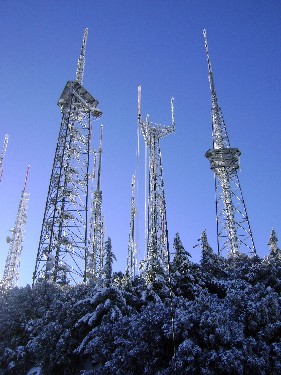
MT. WILSON, CALIF.: It’s Saturday before sunrise at the McDonald’s on Foothill Road in Sylmar, Calf., just west of the San Gabriel Mountains. Ralph Ortiz pulls into the parking lot in his white Ford Explorer.
“There’s not much room,” he says. “I’ve got an IOT in the back.”
Inductive output tube, that is. It’s for a new transmitter being brought online to replace a solid-state one.
Ortiz is the transmitter engineer for the Los Angeles Univision and TeleFutura affiliates, KMEX-TV Ch. 34, and KFTR-TV Ch. 29. His charges are about a mile above the city on Mt. Wilson, where around 50 TV, radio and communications towers rise above the 5,710-foot summit. (Pictured left)
Mt. Wilson is situated on the Southern edge of the San Gabriels, where a late-summer wildfire left nearly 167,000 acres scorched. The mountaintop was spared, thanks to relentless efforts of an army of firefighters, but long stretches of land along area roads are blackened and bare. El Niño rains have loosened rocks and spilled mud across Angeles Crest Highway. Ice and snow has blanketed higher elevations. Access, where possible, is restricted. Ortiz learned yesterday that Larry Lopez, a long-time maintenance man on Mt. Wilson, has gotten through. Ortiz is going up on a Saturday to check the generators. We have to rendezvous with a county escort by 7 a.m. to reach the transmitter facility.
Ortiz takes a circuitous route. He knows every possible way to get to Mt. Wilson. He’s been going up since 1983, when what is now the TeleFutura station was part of the Catholic broadcasting network endeavored by Miller Brewing heir Harry John. It was later added to the Home Shopping Network and eventually sold to Univision.
“Did you ever hear how Home Shopping Network started?” Ortiz asks, and offers the story of how Bud Paxson and Roy Speer once got paid in can openers, which they turned around and sold on air.
FUEL RUN
About an hour into the drive, we meet the county escort truck (right) the main fuel truck and a heavy-duty pick-up with a 400-gallon tank in the back in case the bigger vehicle can’t make it all the way. Fresh snow from the night before provides traction where before there was ice.
Ortiz points at charred power poles along the side of road. Those lines ran to Mt. Disappointment, where the government communications facilities are now running solely on diesel, he says. The power lines to Mt. Wilson come up the other side of the mountain. The broadcast and communications facilities remain on the grid, but outages are common. The generators kick in regularly.
It is now 8 a.m. We’ve gone 60 miles in two hours. Lopez has joined the convey in his red pickup emblazoned with lettering: “Angeles Crest Services.” We follow a county cinder truck as Ortiz gives the rock face on our right a wide berth. Falling debris is a constant danger.
“I saw a guy with his windshield blown out by a rock,” Ortiz says.
As we make the twisting climb, an incredible sight comes into view. A soaring red-and-white guyed tower stretches above the treetops against a perfectly azure sky. Two-and-a-half hours and 70 miles after leaving the Sylmar McDonald’s, we reach Mt. Wilson.
HEADACHE!
The convoy stops briefly at the main entrance, where Todd Smith is running a county front-end loader. The men talk briefly about getting the fuel trucks where they need to go. (L-to-R, the fuel truck drivers, Ortiz, Todd Smith and Larry Lopez.)There’s about a foot of fresh snow. There will be shoveling, despite the massive amount of electromagnetic energy coursing from the towers. In no way does it warm the frigid atmosphere or prevent a layer of ice as thick as a highball glass from covering most of the metal structures.
Ortiz parks the Ford under an ice shield on the KABC-TV tower for reasons immediately clear.
Every minute or so, there’s a cracking sound, like a distant shotgun, followed by a rain of ice shards as chunks crack loose from the towers above. The breakage looks a bit like dust when it gives way 200 or so feet
Ortiz hands me a hard hat. He goes to work clearing a path to the fuel intakes, one on either side of 14 Weathervane Dr., his transmitter facility. Both are behind chain-link gates secured with ice-covered locks. Off he goes with a blowtorch. The two diesel tanks are soon topped off with 300 gallons apiece. Ortiz estimates the generators burn around 25 gallons an hour to power both the KMEX and KFTR transmitters. The two hum along at combined 760 kW ERP, according to the FCC’s database.
Both station signals are broadcast from a candelabra tower currently sporting a red gin pole and attendant cables. Ortiz has a new antenna for KFTR, but it’s lying on the ground for the time being, covered in snow. He fusses over it briefly like it’s a new pet. It makes him nervous to have it lying there where falling ice could pierce the radome. It’s unscathed for now. (Shown left, with Lopez, above, sifting through the snow looking for a fuel intake.)
“When is it scheduled to go up?” I ask as we walk back out to the road.
“Weather permitting,” Ortiz says.
Another crack from overhead.
“Headache!” yells Smith, running with his arms over his hard hat.
MOTHERS OF INVENTION
We head up to the transmitter facility’s living quarters, a small upstairs room in the back of the building with a kitchenette, a toilet and shower, a military-style rack for a bed and a large table sprouting Ethernet cables and a power cord from the center. It shouts of necessity, though Ortiz is a gracious host, breaking out coffee cake, tea, Triscuits and fruit. He makes a completely unnecessary apology for the disarray. It’s warm, there’s TV and food. We power up our computers, but Ortiz soon jumps up and flies out the door to check something else he’s just thought of. It’s clear within a short amount of time in his company that Ralph Ortiz thinks encyclopedically. Such things as straightening up the flat would be a waste of his brainwaves.
A bit later, when he’s settled again at his laptop, a promo comes on for the new NBC show, “Marriage Ref,” showing a woman flossing her teeth in bed as her husband looks on in disgust.
“Vast wasteland,” Ortiz says grinning just a bit, with no hint of irony.
It is by his hospitality I am in this rarified air, so I hesitate to ask about the aluminum foil covering his windows.
“Is it the radiation?” I finally venture.
“No. I just didn’t have anything else to cover the windows one day when I was stuck up here after an all-nighter and wanted to sleep.”
Necessity.
STUCK AT THE OFFICE
Getting stranded is part of the drill for the transmitter engineers on Mt. Wilson. Dennis Doty has been up here going on nine days. His colleagues at KNBC-TV asked at one point if he wanted to be evacuated by helicopter.
“I told ’em no,” he says, waving a paw. Doty is a big man, dressed in a denim shirt and jeans, long hair pulled back into a ponytail. Ortiz and I find him talking with a helicopter pilot who brought up a crew for another station with generator problems. At least two stations went dark in Los Angeles during the El Ni ño storms when their generators shut down.
Doty’s facility is orderly. He takes us through the transmitter room, where the Ch. 4 signal plays on a monitor. I tell him the over-the-air, hi-def transmission of the Beijing Olympics looked almost 3D. He beams.
We move on into a narrow corridor where another monitor displays the remote monitoring software interface. It resembles a virtual bank of gauges showing power levels and a litany of other equipment activity. Doty points to some single RU boxes nearby that he and other KNBC engineers built. Just about every post-digital transition TV facility has homemade equipment among the store-bought gear, given much about the digital platform was invented on the fly.
As we wave good-bye to Doty, I make a mental vow to be heavily laden with homemade cookies on all return visits.
Ortiz drives us further down the road to the sprawling home-away-from-home of Tom Black. The transmitter buildings where Doty and Ortiz work seem positively cozy compared to the one Tom Black haunts. Black handles the combined facilities for KTTV-TV, Fox Ch. 11, and KCOP-TV, MyNetworkTV Ch. 13.
Ortiz enters the building, calling out for Black. “Tom? Are you here?” Nothing. We walk from one room to another to another. No Tom. Ortiz doesn’t say as much, but he’s obviously concerned. It’s clear these guys watch out for each other. Go figure. They are a small group of extremely specialized electrical engineers working in an occasionally hostile, breathtakingly beautiful environment.
“Yeah?”
We finally get a reply.
“I hear you but I don’t see you,” Ortiz calls out.
“I’m in here,” Black says as we turn yet another corner into a small dark room. He’s looking at a boiler that won’t stay lit. His T-shirt says, “I’ll be nicer if you’ll be smarter.” Thankfully, brain plasticity research gives cause for optimism. Not to overdo, but these guys are on the ball in a way affecting but a small subsegment of society. Case in point: “Marriage Ref.”
They are, at the same time, as much earth salt as the farmers and ranchers from whom I inherited my own artless candor.
We leave the uncooperative boiler and follow Mr. Black and his T-shirt on a tour of the facility, including two complete transmitter setups that mirror another. In one, the bank of analog equipment sits dormant, awaiting an unknown fate. The digital transition made instantly obsolete a lot of perfectly functional, very expensive equipment.
“There’s interest in South America,” Black says hopefully.
We make our way to the generator, which stands free in a sort of enclosed carport. If giants had Jaguar E-Types, this would be under the hood. The cylinders are a foot above our heads. The baffle around the exhaust pipe is nearly three feet across. When the generator was first installed and fired up, the exhaust pipe wasn’t insulated, Black said.
“It melted all of the light fixtures,” he said.
OUT OF THE WILDERNESS
It’s mid-afternoon by the time we’ve wandered through Tom Black’s transmitter facility. Our county escort is scheduled to leave at 4 p.m. Ortiz makes a quick loop through the Mt. Wilson Observatory grounds, which are adjacent to the small city of communications facilities. We then regroup with the fuel trucks, Lopez and the country truck, and drive back down the mountain.
We take an alternate route back to the city, now that Ortiz knows the roads are passable. Angelinos line the roadsides that remain open, bringing children up to play in the snow. We pass areas earlier blanketed in snow that’s now melted, the wildfire landscape revealed.
The ash is pretty much washed away now. El Niño put an end to the hot spots that continued to pop up after the Station Fire. The conflagration is finally over.
Mile after mile of dark dirt remains. It’s spotted with what appear to be bristly potted plants that look a bit like Tom Hanks' volleyball sidekick Wilson in “Cast Away.” They are yucca plants, the bases charred black but not to the core. Green spiky leaves shoot from the surviving innards. Nature knows what it’s doing, even if we don’t.
It’s dark again when Ortiz pulls into the McDonald’s parking lot. It’s teaming this time, compared to 12 hours earlier, when there wasn’t a soul around. We make quick good-byes. It was a long day.
I’m back in the marina before long. A different world, at sea level. In the tsunami zone. I turn on the TV. Channel 4.
It’s clear as a bell. -- Deborah D. McAdams
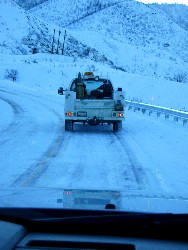
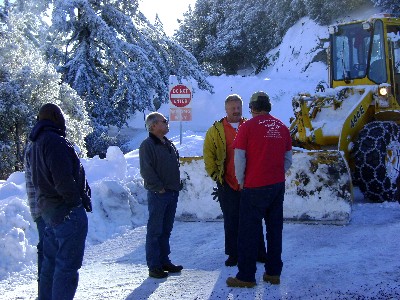
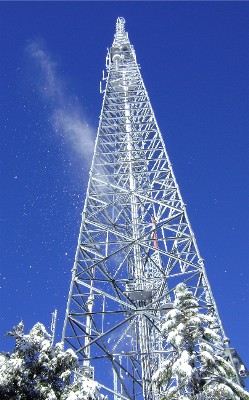
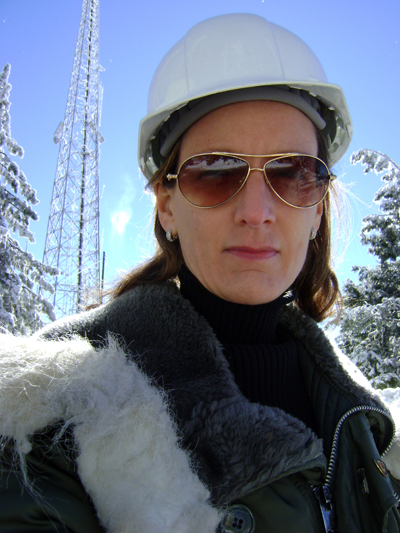
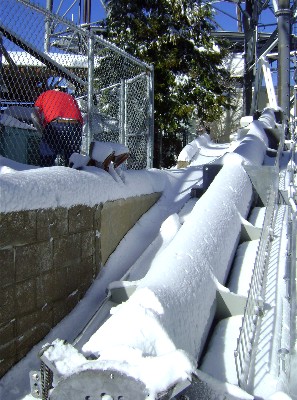
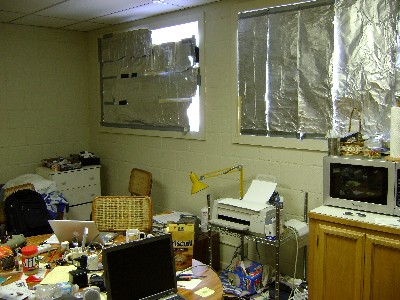
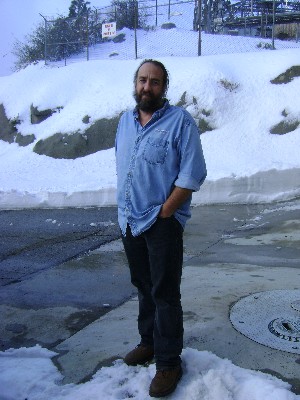
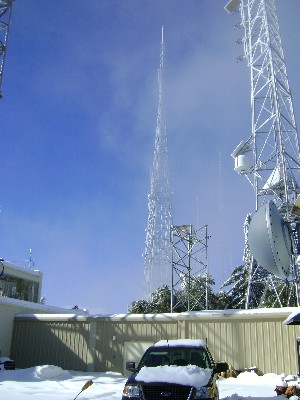
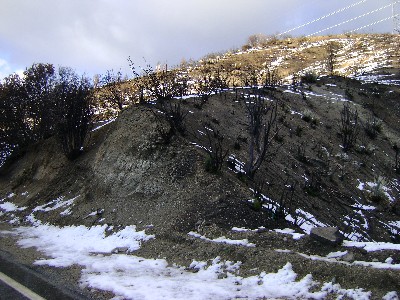
(Front page image, also below, is looking down from Mt. Wilson toward clouds above Pasadena, Calif.All photos by Deborah McAdams.)
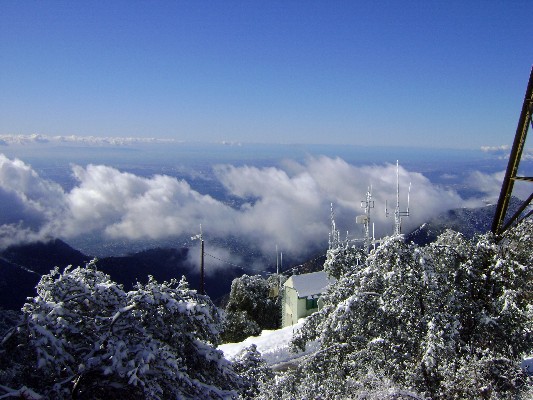
Get the TV Tech Newsletter
The professional video industry's #1 source for news, trends and product and tech information. Sign up below.
